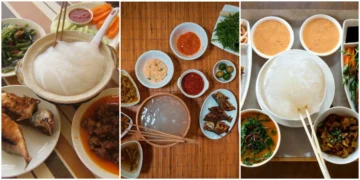Djibouti, located at the crossroads of Africa and the Arabian Peninsula, is a land of striking landscapes and a vibrant cultural tapestry influenced by Somali, Afar, Arab, and French traditions. Among its diverse culinary offerings, one traditional dish stands out as the best food of Djibouti—Skoudehkaris. This rustic, aromatic stew, typically made with tender meat and an array of regional spices and vegetables, embodies the spirit of Djibouti’s culinary heritage. Skoudehkaris not only nourishes the body but also tells a story of community, tradition, and the fusion of flavors that have been passed down through generations.
Why Skoudehkaris Is the Best Food of Djibouti?

Skoudehkaris has earned its esteemed place on Djiboutian tables because it encapsulates the simplicity and depth of local cooking. At its core, this dish is a celebration of everyday ingredients—meat, vegetables, and spices—that, when combined and slow-cooked, transform into a comforting stew with layers of flavor. The technique of simmering the ingredients over low heat allows every element to meld into a harmonious blend that is both hearty and soul-satisfying.
For many Djiboutians, Skoudehkaris is more than just a meal—it is a communal experience. It is traditionally prepared in large pots, meant to be shared among family and friends during gatherings and celebrations. The dish’s rustic character and robust flavors serve as a reminder of the nation’s agrarian roots and its enduring connection to the land and sea. Whether enjoyed during a cold desert evening or as a festive centerpiece, Skoudehkaris stands as a proud representation of Djibouti’s culinary identity.
Key Ingredients of Skoudehkaris
- Meat: Traditionally, Skoudehkaris is prepared using goat or lamb meat—proteins that are readily available and prized for their robust flavor. The meat is cut into sizable chunks to ensure that it becomes tender during the long, slow cooking process.
- Aromatic Vegetables: Onions and garlic form the aromatic base of the stew, providing a subtle sweetness and depth. Additional vegetables, such as tomatoes and sometimes eggplant or okra.
- Spices: The magic of Skoudehkaris is in its spice blend. Local Djiboutian cooks use a mixture that may include cumin, coriander, turmeric, and a hint of chili for warmth. These spices, balanced carefully, imbue the dish with a complex flavor profile that is both earthy and subtly exotic.
- Herbs: Fresh herbs, such as parsley or cilantro, are often added toward the end of cooking, lending a burst of color and freshness that brightens the rich, slow-cooked stew.
- Oil: A neutral vegetable oil or locally available olive oil is used for sautéing the aromatics, ensuring that the flavors develop fully without overwhelming the ingredients.
- Liquid Base: Water or a light broth is added to create a simmering sauce that slowly reduces, concentrating the flavors and melding them into a cohesive, hearty stew.
The Art of Preparation

-
Preparing the Meat: The process begins by cutting the chosen meat (goat or lamb) into uniform chunks. The meat is lightly seasoned with salt and pepper, and in some recipes, it may be marinated briefly with a touch of garlic.
-
Sautéing the Aromatics: In a large, heavy-bottomed pot, a modest amount of oil is heated over medium heat. Finely chopped onions and garlic are sautéed until soft and golden. This step is crucial, as the caramelized aromatics lay the foundation for the stew.
-
Adding Vegetables and Spices: Once the aromatics are ready, chopped tomatoes (and optionally, diced eggplant or okra) are added. The mixture is stirred until the tomatoes break down, forming a rich, thick sauce. At this point, the traditional spice blend—cumin, coriander, turmeric, and a touch of chili—is incorporated. The spices are allowed to toast lightly in the oil, releasing their aromas and intensifying the flavor.
-
Braising the Meat: The seasoned meat is returned to the pot and stirred into the aromatic vegetable base. A measured amount of water or light broth is added, and the mixture is brought to a gentle simmer. The pot is then covered, and the stew is allowed to cook slowly over low heat.
History of Skoudehkaris (Best Food of Djibouti)

The history of Skoudehkaris is intertwined with the broader narrative of Djibouti’s cultural and culinary evolution. Over time, these techniques evolved, influenced by both indigenous practices and the culinary traditions brought by Arab and French traders.
Historically, Skoudehkaris was prepared as a hearty meal to sustain laborers and families through long days in challenging environments. It became a symbol of resilience and adaptability—qualities that remain central to Djibouti’s national character.
Other Authentic Delicacies from Djibouti
- Foodey: A hearty fish stew often made with local spices and fresh seafood, highlighting the coastal influences in Djibouti.
- Shiro: A popular dish made from ground chickpea or bean flour, simmered with onions, garlic, and spice.
- Maraq: A savory broth-based stew that may include meat or vegetables, served with flatbread or rice.
- Anjero (Lahoh): A spongy, fermented flatbread similar to Ethiopian injera, often served with stews and sauces.
- Sambusa: Triangular pastries filled with spiced meat or vegetables, enjoyed as a popular snack or appetizer.










Discussion about this post